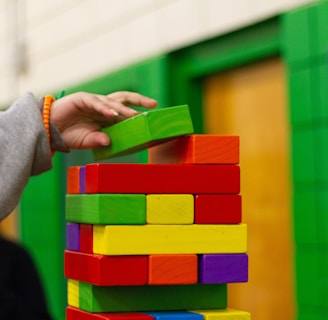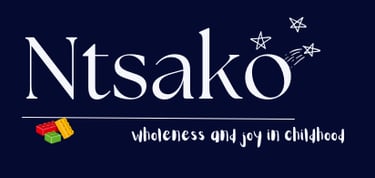
Worldbuilding and Habits
3.1. Why Does the Brain Learn? This might seem obvious, but it has serious implications for our understanding of learning. The young brain is the best place to start understanding this!
ISSUE 3
VJ Tlakula
6/19/20256 min read


The Ever-Learning Brain
The human brain is designed to learn. We have seen in Issue 2 how the brain is quite literally wired in such a way that it grows through learning, and it is structured in such a way that it automatically seeks out learning and stimulation for learning. There is a reason we are encouraged to learn new skills even when we're much older. Because learning keeps our brains active and alive. Even though we are all learning throughout our lives, we learn in different ways at different stages. In this Issue, I hope to illustrate how children learn differently to adults, but also how their learning develops until they come to understand the world the same way we do.
The learning that I’m speaking about is not educational learning. It is not learning that is topical or structured and designed by someone else. This learning is the brain’s innate form of worldbuilding. Existing within a world, figuring out how it works and how best to thrive in it. This is the learning that we are all naturally inclined to do.
As we are exposed to the world and its various elements, our brains constantly form theories about the world and adapt themselves to those theories in the best possible way. This theory-making and worldbuilding isn’t something we do consciously or deliberately, they’re just in us and we do them without even fully realising it.
Learning is at the core of development. It is fascinating to study as it gets us a bit deeper into the young mind so that we can really begin to figure out how children think and why they consequently behave the way they do. Some of their behaviours make absolutely no sense to us, but they make perfect sense to the young child. There is a reason for that. The developing brain is constantly testing out its theories about the world through trial and error. At the same time, this behaviour is automatic, almost instinctual.
How Do We Learn?
Now, a question that psychologists and countless other professions have been asking for centuries is: how do we learn? I have touched briefly on the biological side of it, but even there, there is still so much we don’t know or quite understand. The answer to that question would change so much of how we raise and teach children.
In this Issue, I want to take us through some of the earliest theories of how we learn. These are some pretty old theories, and they’re not perfect in their reasoning. But it’s important to have a bit of an idea about them as they have informed practice in psychology and education in groundbreaking ways and are still influential today. Even though none of them are really perfect, they all have some merit to offer in their own ways, and when used together, they form quite a useful image of how humans learn.
Learning in Young Children
Remember when I spoke of how the young, developing brain is constantly learning and at a fast rate within the first 1001 days of life? Well, a lot is happening in the brain and the child’s life at that point. They are being exposed to this new world in so many different ways, encountering other individuals, and trying to make sense of it in a way that will benefit them most.
They are building their world in their mind and constantly learning about it. In the early days, their behaviour is primarily driven by survival (grasping and putting things in their mouths). At later stages, they will test out and experiment with the world around them. So maybe, throwing things repeatedly, screaming for no apparent reason is part of their learning process.
Because their understanding of and relationship with the world is so different to adults, children will relate to it, solve problems, and perform tasks very differently to adults. Think of how differently you counted as a child (with your fingers or stones) to how you can mentally conduct simple addition and subtraction almost automatically as an adult, because you have a deeper understanding of mathematics than a young child.
The Social Factor
So, humans are ever-learning creatures, but in addition to that, we are extremely social creatures. Whether we love or hate it, we are designed to be social and we're all extremely reliant on one another. Now, there's a whole field all about us being social for survival, but I just want to highlight how learning is also social in nature.
We are constantly learning from and taking notes from our fellow humans. Whether it's how to behave in public, how to solve problems, or how to keep ourselves alive, learning is always happening. Additionally, social interaction stimulates growth and learning. It is the space where our theories about the world are practised and tested with a responsive audience. Because if we do not get that input/feedback, how will we know whether our theory is right?
For example, when a baby repeatedly throws something on the floor or screams, it’s not about being ‘naughty’ or anything like that. It is testing what happens and if what happened the first time they did this thing will happen again. That way they form a theory about how the world works regarding that particular thing.
Because the young brain is a learning brain, it is also an exploring and experimenting brain and is very sensitive to the responses to its actions. Responses influence theories. Responses to these actions by caregivers and those around the young child are crucial to how the brain works in later years.
The caregiver is the main individual that the young child learns about the world through, so their response to the child will impact their learning. Whether it reinforces or discourages behaviours (good and bad). This, in many ways is why you may see a child become very cautious and fearful to explore the world, because they have previously been seriously punished for their actions. Another child may be more confident to explore as they may have received a better response to their actions.
While the young child is learning so much about the world, this is a perfect time to place good behaviours and values in them. Learning theories can help us there too. Because like I said, even though the tendency to learn is automatic in the brain, it needs not only stimulation, it needs guidance, and as habits and neuroscience will show us, the best time to guide the brain’s development is when it’s youngest.
Habits - Little Pathways of Learning
Even though the brain is a constantly learning organ, it is also an organ of habit. Our brains love habits. There is a statistic out there that almost 50% of brain functioning is on autopilot. This is possibly because it takes a lot of power to run something as complex as a brain. To compensate for all that energy and power, once our brains have learned a habit, they almost automatically fall into it without you intentionally making yourself do it.
If you’ve learned something new, when you first start out, it takes a lot of mental effort to do, but once your brain has trained to do that thing, you’ll find yourself doing it automatically. This is a combination of the neural pathways being firmly established over time (like the neurons automatically travelling down a well-travelled road) and your brain creating a theory.
The ‘habits’ I am referring to are behaviours based on established theories about the world and functioning in the world. So, for example, when the brain memorises a negative response (like hitting) to a particular action (like crying), it learns not to cry. So even if the individual is in distress and needs to cry, they will not do so as they feel that it is a negative action and anticipate a negative response to this action.
When they memorise a positive response (like smiling or cuddling) to the action, they learn to do it more or that it is not so bad. Of course, where bad behaviour is encouraged with a smile or reward, the brain learns and associates that reward with something being good. These ‘habits’, if not changed, will follow them into adulthood.
As I’ve said ad nauseum, the young brain is constantly in a state of learning and developing, and as it learns, the brain makes new pathways about how the world works, about which things work a certain way and which don’t. Think of it like pathways in the bush. Why do you think that in the bush, there is a single pathway that everyone (even you) so naturally travel on?
It’s because that pathway has been found to be the one with the least obstacles, that gets you to where you want to be and that gets you there quickly and easily. Same with the brain, when the brain ‘tries’ something new and gets a certain response, it tries it out again to see whether it will get the same response, if it does, it makes a ‘theory’ about that particular thing.
The Takeaway
There are a few things learning theories have in common that suggest why we learn in the first place: for social survival and thriving. Therefore, our learning is always socially mitigated. It can be innate and self-directed to a point, but social interaction always drives that learning with more impact and momentum. In Issue 4, we discuss some of the main ways that children learn about their worlds, but for now, it’s useful to understand how learning works.
So, learning theories are not about how the child learns academically and educationally, they’re about how the young brain makes sense of the world that it finds itself in in a way that helps it to survive and thrive.
This Issue isn’t so much about teaching the theories, rather, I want to touch briefly on them and then apply them to real life to demonstrate their relevance. I want us to really examine how children develop through learning.
Share your Comments Below!
Please feel free to reach out with any comments, questions, and child-related stories
Celebrating childhood and development
© Ntsako Wholeness and Joy in Childhood 2025. All rights reserved.
Copyright Vutlhari Joy Tlakula 2025. All Rights Reserved.


